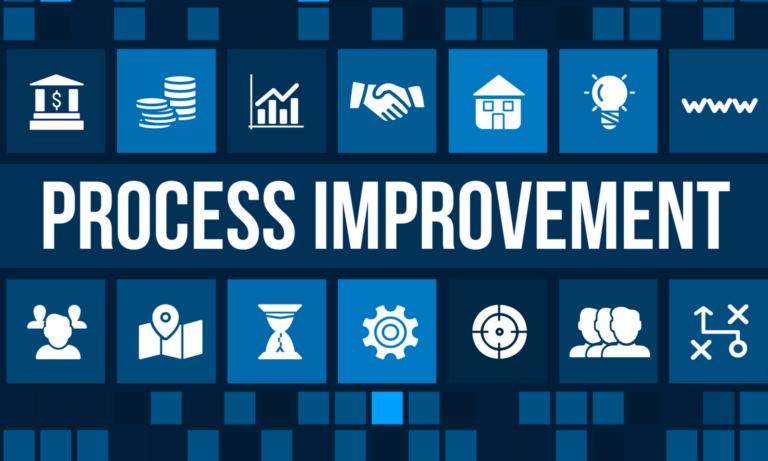Understanding Small Business Process Mapping
Business process mapping involves gaining an understanding of how a company operates in order to identify any areas of inefficiency, gaps or redundancies. This approach emphasizes the importance of transparency and a comprehensive comprehension of the business functioning ultimately leading to increased productivity and business growth.

The essence of Small Business Process Mapping
Small Business Process Mapping is an instrument that assists in outlining the precise steps and their order that a business must follow to provide its products or services. Essentially this process mapping helps identify each task and its role, in the process providing an overview of the entire operational procedure.
Business Process Mapping encourages visualizing the network of tasks, responsibilities and workflows. This provides businesses with a perspective enabling them to understand the interconnectedness and overall flow more effectively.
The process helps businesses gain insights into how each of these tasks contributes to the effectiveness and efficiency of their operations. This visual representation assists businesses in identifying any obstacles, inefficiencies or unnecessary steps that could hinder productivity.
Moreover, by organizing and monitoring these process maps businesses can streamline their operations effectively enhance communication and allocate resources efficiently. Ultimately this results in improved business performance.
Importance of Small Business Process Mapping
Efficient and organized operations lead to smoother processes increased productivity, reduced chances of misunderstandings and enhanced customer satisfaction.
Within business process improvement are powerful tools. Process mapping is one of those tools within the Six Sigma framework. You can learn more about the Six Sigma framework in our article, Applying Lean Size Sigma Principles to Small Businesses.
Small businesses can utilize Business Process Mapping to assess the time, effort and resources required for each procedure. This helps them plan effectively and improve efficiency.
Six Sigma, a set of techniques and tools for process improvement, focuses on identifying and removing the causes of defects and minimizing variability in manufacturing and business processes.
It uses a set of quality management methods, mainly empirical, statistical methods, and creates a special infrastructure of people within the organization (such as “Black Belts” and “Green Belts”) who are experts in these methods.
On the other hand, process mapping is a technique used to visually represent and analyze the steps involved in a process. It helps in understanding, documenting, and analyzing how a particular process works, and is often used in conjunction with Six Sigma methodologies.
By mapping out a process, organizations can clearly see areas of redundancy, delays, and bottlenecks, making it easier to apply Six Sigma techniques to improve efficiency, reduce waste, and enhance overall process quality.
The relationship between process mapping and Six Sigma
The process mapping and Six Sigma relationship is deeply synergistic, as both are integral to effective process improvement and quality management in businesses.
- Foundation for Analysis: Process mapping serves as a foundational step in the Six Sigma methodology. By visually outlining the steps in a process, it provides a clear, detailed view of how the process currently operates. This visualization is crucial for identifying inefficiencies, redundancies, and bottlenecks.
- Identifying Improvement Areas: In Six Sigma, one of the primary goals is to identify areas where processes can be optimized to reduce waste and defects. Process maps help in pinpointing these areas by making it easier to see where delays or unnecessary steps occur.
- Data Collection and Analysis: Six Sigma heavily relies on data to make informed decisions. Process mapping aids in identifying where and what kind of data should be collected. By understanding the flow of a process, Six Sigma practitioners can better determine key points for data collection and subsequent analysis.
- Facilitating Communication: Process maps are effective communication tools. They help in explaining the process to team members, stakeholders, and Six Sigma professionals. This shared understanding is vital for collaborative Six Sigma projects.
- Monitoring Improvements: After implementing Six Sigma improvements, process maps can be updated to reflect changes. This not only helps in documenting the improvements but also in monitoring the ongoing efficiency and effectiveness of the process.
- DMAIC Framework: Six Sigma’s DMAIC (Define, Measure, Analyze, Improve, Control) framework often begins with process mapping in the Define phase. It helps in setting the boundaries of the process to be improved and is revisited in subsequent phases for further analysis and improvement.
In summary, process mapping is an essential tool in the Six Sigma toolkit. It provides the necessary groundwork for understanding and analyzing processes, which is critical for the data-driven, systematic approach that Six Sigma promotes for process improvement.
Identifying processes for mapping
When it comes to improving business outcomes Small Business Process Mapping plays a role. However, its effectiveness hinges on pinpointing which processes need to be mapped. It’s important to remember that not every process within an organization needs to be mapped out.
Some processes may be too straightforward or overly complicated making the mapping process unnecessary or burdensome. On one hand, the simpler processes may not require any modifications or substantial enhancements.
However, it’s worth noting that intricate procedures can be quite time consuming and resource intensive to map out making this approach inefficient. Hence determining which processes need to be mapped becomes a step in Small Business Process Mapping.
This enables you to concentrate on operations that have the potential for improvement or streamlining, thereby ensuring the effectiveness of the outcomes achieved through this practice. Such an approach guarantees the utilization of resources and time fostering growth and enhanced efficiency within your business.
Steps in Small Business Process Mapping
1. Start by clarifying the purpose: It’s essential to have an understanding of why specific processes require mapping so that we can concentrate on what matters.
2. Next provide a breakdown of the steps involved: Take the process. Visualize it step by step from its initiation to its completion.
3. Determine the roles of each worker involved: It’s important to identify and assign responsibilities to individuals participating in the process.
4. Perform an analysis and evaluation: Look for any inefficiencies within the process and evaluate them thoroughly.
5. Finally implement improvements based on your findings: Make changes. Continuously assess their impact over time.
Types of Small Business Process Maps
The complexity of BPM can vary. There are types of process maps that serve purposes and offer unique advantages. These range from flowcharts that outline the steps of a process to detailed diagrams that clarify who does what and when.
Choosing the right mapping tools
Choosing the appropriate mapping tool is a critical aspect of small business process mapping. Using these tools can greatly simplify the process. Make it less overwhelming to complete. While it may seem like an investment upfront dedicating time and resources to an adaptable mapping tool can yield substantial long-term advantages for your small business.
These tools are equipped with a range of features that are tailored to meet the needs of businesses. From enabling the visualization of complex processes to facilitating understanding and communication among team members, these tools can be game-changers. They can also aid in identifying redundancies, bottlenecks, and inefficiencies in the routine workflows, providing actionable insights to drive process improvements.
Selecting the mapping tool not only saves time and minimizes mistakes but also empowers small businesses to boost their performance streamline operations and ultimately enhance their financial outcomes. Consequently, although it may appear as an investment a suited mapping tool can significantly contribute to the expansion and triumph of your small business.
Efficiently Use Process Map Diagrams
Process map diagrams are representations that depict business processes. When used properly these diagrams can provide insights to businesses regarding their operational methods leading to improved efficiency and significant growth.
Benefits of Small Business Process Mapping
Small Business Process Mapping is a tool for medium sized businesses looking to boost their operational efficiency. By adopting this approach such companies can witness enhancements in their productivity levels. This improvement happens because process mapping helps identify and remove inefficiencies resulting in utilization of resources and time savings.
Furthermore, the thorough analysis involved in process mapping also enhances the quality of services delivered ultimately boosting customer satisfaction and elevating the company’s reputation in the market. This is achieved by identifying and rectifying any areas where the service delivery process may encounter obstacles ensuring a provision of high-quality services.
Process mapping can also contribute to cost reduction by identifying areas of spending and inefficiencies. By implementing solutions based on these findings we can save costs. Additionally process mapping offers a view of the business operational activities enabling informed decision making. This leads to a efficient and highly profitable business in todays environment. The strategic advantage that Small Business Process provides is crucial.
Mapping offers can be invaluable.
Here are some important tips to ensure process mapping;
1. Make sure you have a purpose in mind.
2. Involve the people who actually use the process in the mapping.
3. Keep the map simple and concise avoiding complexity.
4. Regularly review and make improvements to your map.
Remember these steps are crucial for effective process mapping!
Challenges in Small Business Process Mapping
Implementing process mapping in a business can be quite challenging. It involves facing resistance from employees dealing with limitations and addressing the absence of process documentation. However, overcoming these obstacles is essential to ensure a process mapping exercise.
Process Mapping: A Continuous Improvement Tool
Process mapping is a tool that needs to constantly evolve alongside process changes in order to ensure its ongoing effectiveness. When implemented correctly it can yield advantages for businesses, including cost reductions, process enhancements and improved overall efficiency.
Conclusion
Effective process mapping is a transformative tool for small businesses seeking to enhance their operational efficiency and quality. By meticulously charting out each step of a business process, small business owners and managers gain invaluable insights into the inner workings of their operations.
This clarity not only highlights areas ripe for improvement but also fosters a culture of continuous improvement and efficiency. Process mapping, when done correctly, is more than just a diagram; it’s a roadmap to streamlined operations, reduced waste, and enhanced customer satisfaction.
Moreover, the integration of process mapping into the daily operations of a small business can lead to significant long-term benefits. It empowers businesses to make data-driven decisions, aligns team efforts towards common goals, and sets a foundation for applying methodologies like Lean and Six Sigma.
As small businesses face the challenges of a dynamic market, the ability to adapt and optimize processes quickly becomes a crucial competitive edge. Ultimately, effective process mapping is not just a strategy for growth; it’s an essential component of sustainable business success in an ever-evolving business landscape.





